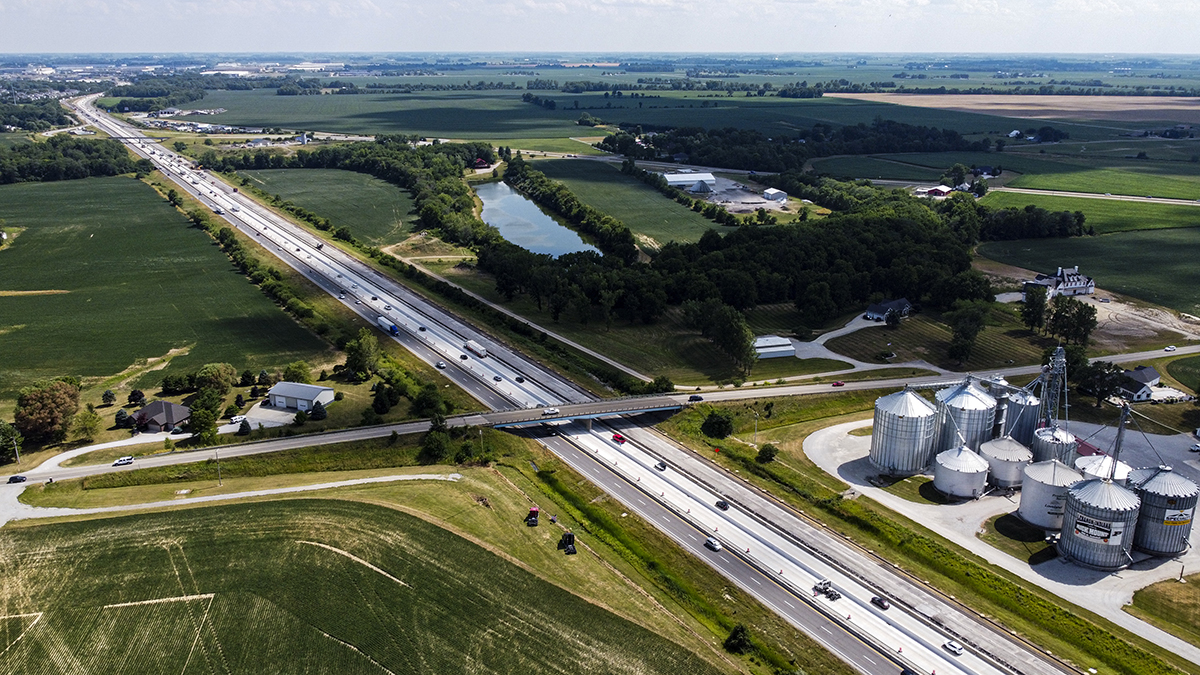Subscriber Benefit
As a subscriber you can listen to articles at work, in the car, or while you work out. Subscribe NowWith an effort to develop an innovation and research district in central Boone County underway, the state’s transportation agency is pushing ahead with plans for an Interstate 65 exit at West County Road 300 North that would serve the sprawling project.
The Indiana Department of Transportation is also planning improvements to the existing interchange at I-65 and U.S. 52, just south of the proposed new interchange. While financial details have not yet been made public, the project is expected to be paid for by the Federal Highway Administration.
Preparation for an interchange coincides with state moves to advance the LEAP Innovation and Research District, a project spearheaded by the Indiana Economic Development Corp. that will occupy upward of 7,000 acres along the western and northern outskirts of Lebanon.
The district’s northern section—which will be anchored by a $2.1 billion advanced manufacturing project by Eli Lilly and Co. announced in May—will extend as far out as West County Road 450 North.
INDOT last month notified local and state officials—as well as a handful of outside organizations—that it is proceeding with improvements to the I-65 corridor. In its notification letter, the agency said the project is being driven by the innovation district and continued growth in Boone County.
“The purpose of the proposed [interchange] project is to provide improved mobility and direct access to the areas east and west of I-65, north of Lebanon, including future planned land uses,” the June 21 correspondence said. “Additionally, the purpose of the proposed project is to reduce future traffic congestion that is expected as a result of the anticipated economic development” in those areas.
The INDOT letter, authored by Matthew S. Coon, acting manager of INDOT’s environmental services cultural resources office, came about the same time the IEDC began moving forward with a petition to annex into Lebanon about 56 properties that will be part of the LEAP district. That process is ongoing.
INDOT said American Structurepoint Inc. and Weintraut & Associates are handling the project’s environmental due diligence. Those firms are based in Indianapolis and Zionsville, respectively.
INDOT Public Relations Director Megan DeLucenay declined to discuss the project in detail, noting INDOT is in the “very, very early stages” of planning.
“As of right now, we have not identified design elements or a timeline, but we will keep the public informed on any updates once they’re decided upon,” DeLucenay said, referring additional questions to the letter sent by Coon.
IEDC said the LEAP project will include other road and infrastructure improvements, including to state roads 32 and 39 and U.S. 52. The project is expected to take decades to complete, with sections built in phases as users express interest.

(IBJ photo/Mickey Shuey)
Traffic a concern
Despite the promise of new, high-paying jobs—the average salary for the 500 people projected to be employed by the Lilly development alone will be about $95,000—some nearby residents aren’t thrilled about the anticipated traffic increase.
Lin Ellis for 20 years has lived in a home on West County Road 450 North, and her property is across from the planned Lilly facility, about 1-1/2 miles north of the proposed interchange.
Ellis, who trains horses, said she worked for Lilly in Indianapolis for 40 years and is concerned about the impact the development—and the interchange—will have on traffic and her business.
“That would impact me, and it would impact people coming to my ranch directly because there’s going to be more traffic and a different configuration,” she said. “Obviously, I moved out here because I didn’t want traffic.”
Even before the LEAP project, there were discussions about adding an interchange north of Lebanon, with INDOT considering either C.R. 300 North or C.R. 450 North.
Jeff Wolfe, president of the Boone County Commissioners, said those talks go back several years, but he’s not sure whether current plans are in line with previous considerations.
“There were drawings and proposals made a couple of years ago, and then at that point in time, it was decided … not to do it, but it has come back again,” he said. Wolfe added that most residents have been so enamored with the innovation district plans that they’ve generally overlooked the interchange plans.
Lebanon Mayor Matthew Gentry and many county officials have generally supported adding an interchange at C.R. 300 North. Gentry couldn’t immediately be reached for comment for this story.
An interchange project can take as few as three years and as long as 10 years, from the time it’s conceived to the time it opens—it just depends on the project.
Buying land
INDOT has not yet determined exactly how much land—or which parcels—might be required for the interchange, but it’s possible the agency could use eminent domain to purchase the land if owners aren’t willing to negotiate a sale on their own. The process allows a government entity to force owners to sell at fair market value land needed for a project for the public good, such as transportation or infrastructure.
The Dean and Mary Jackson family, which owns much of the land on the north side of C.R. 300N, both east and west of the interstate, has agreed to sell some 136 acres in that area for use in either the LEAP district or the interstate project, or both. The Jacksons are among more than 30 owners who have agreed to sell their land to the state and have it annexed into Lebanon.
However, the state hasn’t said whether it also needs other parcels for the interchange project.
An IBJ analysis of the area found at least seven single-family homes and one large farm operation would be consumed by the interchange project, assuming a typical four-leg design with on and off ramps in each direction.
That doesn’t include a large single-family house under construction less than 800 feet from the C.R. 300 North overpass.
“The engineers are going to have to determine how much they need and then work with the landowners to come up with something that’s fair and equitable to them—above and beyond what farm prices may currently be,” said Mike Horrigan, a land broker with the Indianapolis office of South Bend brokerage The Bradley Co.
“The state is very well versed in what they need to do as they make improvements along the interstates and state roads,” he said.
Phil Beer, owner of Indianapolis-based civil engineering firm USI Consultants Inc., which has worked on several interchange projects in Indiana and beyond, said once an environmental impact study is complete—it has already started—the state will have to further investigate utilities and traffic counts. He said funding is sometimes a hurdle for interchange projects, but once that’s secured, work moves rather quickly.
State and local officials will want “to move forward as fast as possible, but there are certain regulations, certain hoops, that they’ll have to jump through,” he said. “Anytime there is a big development going in, [understanding] how the traffic is going to move” must be part of the conversation.
Key location
Doug McCoy, the Al and Shary Oak director of real estate at Indiana University, said adding an interchange north of Lebanon is not surprising given the large-scale investment the IEDC is eyeing for the area. He added that, while such a project could cost tens of millions of dollars, it is “tremendously important” to the long-term success of LEAP.
“Without the access,” he said, “a project is just not, probably, going to work—it’s not going to happen. It’s all about getting people in and out of there.”
McCoy said it’s likely the decision by Lilly and others to develop at the site is contingent upon an additional interchange.
Horrigan agreed, adding that accessibility will be key for the project to attract users and spur additional growth in and around Lebanon, whether it’s associated with LEAP or not.
“If you look at what Indiana’s trying to do, as far as pull in additional jobs and different types of industries, [the interchange] will be a big benefit,” he said. “They’re trying to create something that’s going to compete with areas like the North Carolina Research Triangle Park. They want to create an environment like that, and this is one of the first steps.”•
Please enable JavaScript to view this content.




IBJ writes: “The Indiana Department of Transportation is also planning improvements to the existing interchange at I-65 and U.S. 52, just south of the proposed new interchange.”
“Improvements”, is a pejorative term that INDOT has duped the media and the public into using to describe its construction projects. They want people to think that everything they do is for the better of the public. We know that is far from the truth.
How about using the term “changes” instead of the pejorative “improvements”. “Changes” better describes what INDOT is doing, and leaves the opinion to those in the area whose lives are impacted to decide what is better or worse.
I work for The State of Indiana and see “improvements” like this every day. It’s challenging for cities, towns, and infrastructure to grow without push back from land owners. This includes public water supply for utility companies. The project already has big teeth and some are dug in. I’d join the 30 owners already offering to sell land. They will get more than market rate… they usually do. Otherwise you’re standing on the tracks starring down a moving train. You don’t win long term.